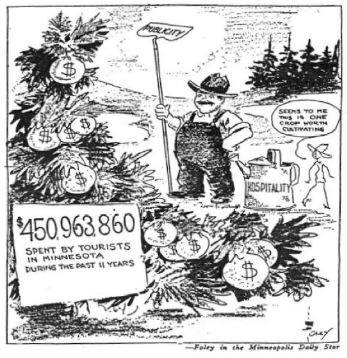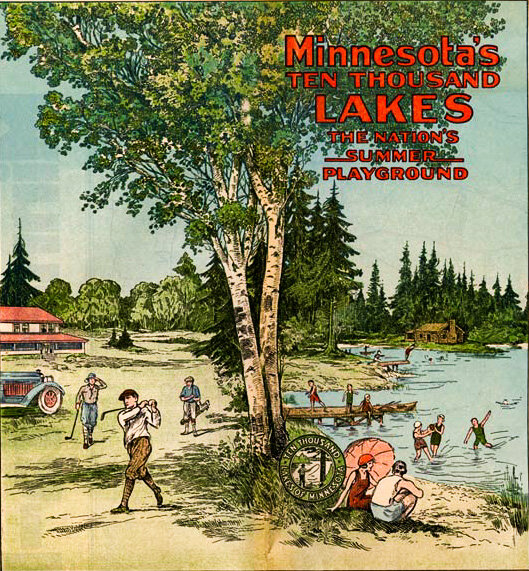The Ten Thousand Lakes of Minnesota Association
Have you ever wondered how Minnesota became known as the land of 10,000 lakes? Every Minnesotan knows that the state boasts closer to 11,842 (give or take) lakes–significantly more than, say, Wisconsin. That number swells to 28,176 if you include ponds and wetlands, too. So where did the perfectly round number of 10,000 come from?
The rise of the automobile industry brought with it a surge in tourism opportunities for middle-class Americans. People were becoming more mobile and looking for new adventures in places they have never been to. The state recognized this as an opportunity to market Minnesota as a great place to take a vacation. Communities across the state began establishing public tourist camps to meet the needs of auto campers. Meanwhile, Twin Cities real estate firms led the effort to develop affordable cabin sites on many of the states most accessible lakes. It was clear that the time had come time to capitalize on Minnesota’s cool summer weather, diverse scenery, and recreational opportunities like canoeing and fishing to a national audience. So in 1917, the Ten Thousand Lakes of Minnesota Association was established to lure the adventuresome middle-class to the state.


The Ten Thousand Lakes of Minnesota Association was formed with funds contributed by more than 50 communities throughout the state. The money was used to create and distribute a film about canoeing on the Mississippi, place ads for the state in national publications, and produce beautifully-illustrated pamphlets and postcards touting the state’s diverse vacation opportunities. The slogan, “Land of 10,000 Lakes,” was created to showcase the state’s recreational resources. None of their other slogans–such as “The Bread and Butter State Invites You”–stuck quite like “Land of 10,000 Lakes” did.
All of the association’s work paid off. Within ten years, people across the country recognized Minnesota as an alluring place to vacation and brought more tourists to the state than the association ever imagined. Ten Thousand Lakes president Arthur Roberts recognized the boon to the economy and shared that the expenditure of $50,000 was one of the best investments the citizens of Minnesota would ever make. He went on to explain why: “Tourists are good business stimulators. Most of them are good buyers and they have cash to spend here.”
In the 1930s, tourism had become a mainstay of the state’s economy with tourist expenditures totaling over $100 million. The need for a permanent, long-term department to handle the rising interest in Minnesota for vacationers led to the formation of the Bureau of Tourism within the Department of Conservation. Once the bureau was up and running, it took over marketing the state for tourism and the Ten Thousand Lakes of Minnesota Association was dissolved. The Bureau of Tourism built on the foundation laid by the association for economic development within the state and marketing Minnesota’s tourism assets nationally–and eventually internationally. Today, Explore Minnesota continues that work. In 2018, tourism had grown into an industry that brings $15 billion into the state and provides more than 265,000 jobs.
